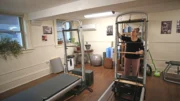Learn ways to reduce challenges in the garden and adapt to gardening as you age gracefully.
The physical benefits of working in the garden are a perfect complement to the tangible rewards of creating a beautiful space or harvesting the freshest vegetables. It might creep up on you, but the physical demands of garden work can become a challenge with age. To that end, a gardener whose body was up to the rigors of wielding bags of potting soil, wheelbarrows laden with compost, or digging holes to accommodate balled and burlap-wrapped plants will have to adapt as the body balks at such chores. If you find that the challenge of creating the garden of your dreams no longer aligns with your body’s reality, it’s time to re-evaluate how you work in the garden and adapt to those changes.
Abandon perfectionism. This can be hard if you’ve held your garden to a standard that required gobs of attention and care. Prioritize areas of your garden where you spend time or are ever-present views from inside your home. Re-think areas that you rarely see or use. Make conscious decisions about where the tended garden ends and either plant a border of easy-care shrubs or weed whack the space a couple of times a season.
Be a realist. Consider your time, budget, and physical abilities. Prioritize from there—your garden should be a pleasure, not a burden. It may mean eliminating areas you’ve tended in the past and turning them over to less labor-intensive plantings. Use Ergonomic Garden tools such as, ratcheting pruner, telescoping pruner, fulcrum weeder, quick release hose connector and lightweight expandable garden hose. (See Photo at the following link: https://extension.psu.edu/gardening-as-you-age
Ask for help. If you can afford a garden helper for things you can no longer do yourself, go for it. Knowing that someone is coming for even half a day each week is liberating and can keep you excited about working in the garden, rather than feeling like it’s a millstone around your neck.
Embrace raised beds. Planting, maintaining, and harvesting vegetables without straining your back will make your garden a pleasure rather than a burden. Ornamental containers, elevated from the ground, whether at your front door or in areas where you spend time relaxing outdoors, allow you to tweak and maintain pretty vignettes without strain and hassle. They can punctuate areas you’ve simplified, whether with hardscape or plantings that require minimal care.
Employ containers as large as your space and budget allow. Think about the time required to maintain a 4-inch pot versus a 24-inch pot, one requires daily attention, and the other gives you wiggle room, except for the hottest and driest times of the year. Better to care for a couple of capacious containers than a passel of puny pots.
Plant shrubs. Choose those that colonize and take over a bed in lieu of perennial plantings that require more time to maintain. Carefully chosen, they can add interest the entire year. From lower growing plants such as fragrant sumac (Rhus aromatica ‘Gro-Low) to larger options such as Carolina allspice (Calycanthus floridus), there are plants that will shrug off deer, drought, and poor soil, filling space and adding interest without adding maintenance.
Employ groundcovers. Once you’ve planted shrubs, add groundcovers to complement them. A sunny hillside planted with junipers or ornamental grasses can be underplanted with moss phlox (Phlox subulate) or sedum species. Both will battle erosion and look beautiful throughout the growing season. Choose creeping phlox (Phlox divaricata) or bugleweed (Ajuga species) rather than bark under an old planting of rhododendron or boxwood and create a pretty vignette. A shady spot under a tree can hold ferns and Canadian ginger (Asarum canadense). Both options look beautiful, suppress weeds, and obviate the expense of spreading bark mulch year after year.
Work smarter, not harder. Tools abound to make chores easier in the garden. Look for kneelers and scooters as stooping and bending become a challenge. Extended or wider handles can make life easier for stiff backs or arthritic hands. Lightweight coiled or fabric hoses can
make watering easier than lugging the older, heavier versions around the garden.
A proactive approach to meeting the challenges of age or physical changes can make your garden a pleasure, not a burden. Having a place to re-charge and relax can bring health benefits not found in a bottle or at a doctor’s office and can be a great way to keep your body at its best with age.
Authors
Carol Papas
Master Gardener, Allegheny County
Penn State Extension
7/8/24, 11:08 AM Gardening as You Age
https://extension.psu.edu/gardening-as-you-age





























